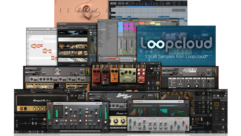In this edition of the SVC Podcast, Contributing Editor Bennett Liles continues his talk with Chad Hess technical director at Florida Hospital Church about the new KLANG controlled Shure stage monitoring system the church recently began using. Chad describes how the musicians use Amazon Fire tablets to set up their 3D monitor mixes.
Links of Interest:
- The Florida Hospital Church in Orlando
- The Amazon Fire tablet used by the musicians to set up their mixes
- The Allen & Heath dLive Series, future upgrade target at the church
Download Podcast Here:
https://s3.amazonaws.com/nb-svc/public/public/186-2_AVnew_Florida_Hosp_C…
This is the SVC Podcast from Sound & Video Contractor Magazine with Pastor Chad Hess of the Florida Hospital Church and you can find show notes and product links for this one in Sound & Video Contractor Magazine at svconline.com.
Stage monitoring can be a difficult thing to get everyone in a live music group to agree on but when the Florida Hospital Church put in a new KLANG controlled monitoring system it turned the musicians loose to get creative and mobile. Technical Director Chad Hess is back to finish up on how he AVnew in Orlando got it done. Coming up right now on the SVC Podcast.
Chad, good to have you back with us from Florida Hospital Church in Orlando. You’ve got so many different things there musically. It’s a different setup every week and then you have to strike all of that stuff right back down to a bare building, right?
That’s correct. There’s another church that rents from us on Sunday mornings and then we have other events during the week as well. So it’s a very multiuse space, which means we’ve got to keep that stage clear which is another benefit of a wireless monitoring system. It’s less cables I have to strike every week. So that’s been a nice adjustment as well. [Timestamp: 1:18]
That is a great thing when it comes to physically laying everything out. I would think that one of the trade-offs might be some coordination required on the RF that might be the tricky part of it.
Yes. RF coordination is always a tricky one, but it seems to have worked pretty well. We’ve had to adjust on frequency, but otherwise it’s been pretty good from our initial setup. [Timestamp: 1:40]
That’s fairly remarkable for the Orlando area. That place is really cooking in RF anyway.
Yes. Now when we replace all of our 600 MHz and we crowd it all in the frequency, that story may change. But we’ll make sure to coordinate that well when we do it. [Timestamp: 1:54]
That’s going to be a pretty big job, I would think.
Yes.
We were talking last week about how the musicians went from a corded or wired stage monitoring system to this KLANG controlled wireless IEM setup. What was the Shure part of it?
Shure PSM 300 IM’s.
And there’s a way that they can use Amazon Fire tablets to control their monitoring?
Yes. So that was another benefit that I really liked with the KLANG is it can be controlled from $50.00 Amazon Fire tablets. You know, all of your sound boards and stuff, you can have them remotely accessing a mix via iPad or something, but then you’ve got to buy $250.00-$300.00-$500.00 iPads. Well, when you’re buying eight of them that cost savings is quite significant. I mean you can use iPads. You can use phone. You could use any computer, any number of devices, but being able to use the Fire tablets really made that an economical choice. [Timestamp: 2:52]
That’s got to fun to work with. Exactly what do they do when they come in to get that all ready to go?
The Fire tablet is connected to the KLANG base station, so to speak, for the KLANG. And that just connects via Wi-Fi, and that is how they control their mix. It’s a pretty simple, easy-to-use interface there that they control. And then that all gets fed out into the PSM 300’s that they’re wearing that actually gives them the sound. [Timestamp: 3:21]
And how far away are those? What’s the transmission distance on that system?
The actual receiver is in our control room probably 80 feet away, but the antenna is right there on the stage. So they’re pretty close to the antenna. [Timestamp: 3:35]
I find that on a lot of church wireless systems, the antennas are the most neglected part of it and the way they connect back to the receivers and then the receivers then get all the bad rap when the system doesn’t work right.
Yeah.
And this is a DANTE system that you have, right?
Yes, it is.
Okay, so that makes things a little easier.
It also saves me all the bus processing on my board. I don’t have to have eight stereo mixes, 16 buses to eat up on my board, which I don’t think I even have. So that’s nice that I can just feed it all through DANTE and keep that processing off of my board. And we already do Dante for a lot of different things. That’s how we send from house to broadcast and multitrack record and stuff like that. So we’re very familiar with DANTE to begin with and that made it a very easy integration. [Timestamp: 4:24]
And once you’ve got that down it’s just a matter of plugging in more things.
Yeah. This setup of the KLANG system with the DANTE is actually surprisingly easy. [Laughs] Once I figured out what channels I want where and got all that routing sorted out in DANTE, really I turned on the KLANG, I went in and told it how mixes I wanted, and named the channels and everything was working. It was just very simple once you got it all pushed in the right spot, and with the name on it, it was done. It didn’t take a lot of fiddling, which really kind of surprised me. [Laughs]. [Timestamp: 5:01]
Yeah, that’s what I hear from just about everybody. Once you’re familiar with it, simplicity of setup and operation seem to be the most attractive things.
Yeah.
Oh, and I was going to ask you about your mixer. What type of mixer do you use there?
Our house mixer is an Allen & Heath iLive. Broadcast is an Allen & Heath GLD.
Well, I’m using an Allen & Heath mixer to do this so as far as I’m concerned you can’t go wrong with that.
Yeah. Someday soon we’ll upgrade that to a dLive, but right now we’re running on the iLive. [Timestamp: 5:28]
One thing that seems to be the same everywhere. The musicians have their own monitoring mixes and when they practice, do the sound levels tend to keep going up?
Like their individual levels or their mix?
I would think the whole mix because most likely nobody ever turns anything down.
[Laughs] It’s true. And that’s another piece that I loved with the KLANG is that’s exactly the problem that you tend to run into a lot with musicians when they’re mixing their monitors is oh, I need more of that and then I need more of this and more of this. Pretty soon everything is at 10 and it’s all muddy and fighting each other and you can’t hear anything. But with this one as soon as you moved an input all the way up, if you hit up again it automatically lowers everything else, which is really what needs to happen. If you’re needing more of that and you can’t push it any more, you need to bring other stuff down. But this does that automatically for them so it still makes it very intuitive for them. “I need more of this.” Okay, well then I’ll bring everything else down. [Timestamp: 6:29]
That would seem to save a lot of time and confusion, too.
Other mixers can do that, but not this user-friendly and intuitively.
What kind of physical layout is there to the church?
The capacity of our building is 500. We average about 750-800 between two services.
And you fill all of that space up and then take everything down and store it and you do that every week because there are other things going on there.
Correct, yeah. There’s another church that rents on Sunday and then other groups that are here all during the week. We have people here every day – day and night. [Timestamp: 7:02]
Do they use all of the same equipment that your people use?
Not a lot of the groups use the worship center, although we do have some. The rest of the building is used quite a bit. But any other events that are in the worship center, most of those are like – actually the hospital does their orientations here for new employees and so they use our system, but in a very basic way. They don’t use the monitors, you know, the in-ear monitors because it’s not live music, but they use the soundboard and the projector and light and stuff. We just have simple presets for them that they recall and give them what they need. [Timestamp: 7:37]
And Gil Parente over at AVnew initially set all of this up for you. He suggested the KLANG system.
He’s the one that showed us the KLANG system. And he’s been our integrator for years so he’s installed most of the stuff that’s here in the church – at least all the new stuff.
A lot of good technical contacts come through the church membership and who would better know what’s needed than people who are there all the time?
Exactly. It’s been very beneficial that Gil is both a church member as well as a great integrator. So he knows our needs very, very well and he also knows the marketplace. He knows what’s out there. And so he’s a great one to day hey, I think this is going to be a great fit for you guys. Why don’t you check this out? And so we’ll look at it, we’ll talk about it. [Timestamp: 8:26]
You told us about the mixer. Is that going to be the next tech upgrade for the church? What’s next for upgrades?
Microphones is the first one thanks to the FCC auction. That will be coming up this year and we’re already in the midst of planning all that and doing some demos of capsules to choose that. So that’s the next big one that’s happening. After that would probably be a new mixer. The GLD and broadcast is limited to 48 inputs and we hit that limit a few times a year. So we need more capacity both in-house and broadcast so we’re looking to do some upgrades there. [Timestamp: 9:00]
The RF mic situation is always fluid and it can be tough to sort of chart a course through that with all the changes going on. That’s a lot of plates to keep spinning for you I’m sure.
Yeah. [Laughs] Yeah.
Great hearing about it Chad. Florida Hospital Church and Chad Hess the technical manager with their new KLANG controlled Shure IEM system. Thanks for telling us about that and about your church.
Thank you. I’m glad to be here.
Glad you were here with us today with Chad Hess. The show notes and some handy links for this one are on the Sound & Video Contractor Magazine web site at svconline.com. Be back with us again right here next week for the SVC Podcast.










